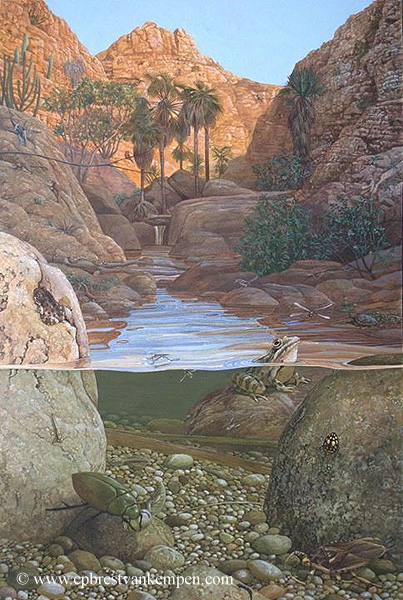 acrylic on illustration board 24" x 16" |
Situated
on the southeastern front of the Sierra El Aguaje, a volcanic
mountain range formed some five million years before the Sea
of Cortez, Nacapule Canyon harbors a unique and diverse ecology,
where tropical deciduous scrub forest transitions into the Sonoran
Desert. It marks the northern range limit of many tropical species
and genera as well as the southern limit of many Sonoran Desert
taxa. The canyon takes its name from the Nacapule Fig[1] (Ficus
pertusa=Urostigma erythrostictum), one of three fig species
in the canyon. The small Rock Fig[2] (Ficus petiolaris=palmeri)
sprawls up rock faces while the stately Ficus insipidus[3]
grows near the canyon floor, which is dominated by Mexican Fan
Palms[4] (Washingtonia robusta) and the smaller San Jose
Hesper Palm[5] (Brahea brandegeei), which also grows on
the igneous canyon slopes composed of rhyolite and rhyodacite.
The flora of the arid, south-facing slope is typical of the Sonoran
Desert. It includes many cacti, including the massive Cardon[6]
(Pachycereus pringlei), the Organpipe Cactus[7] (Stenocereus
thurberi), and the endemic Guaymas Hedgehog Cactus[8] (Echinocereus
engelmannii llanuraensis), two maguey species, Agave colorata[9]
and A. chrysoglossa[10], and such desert trees as the
Palo Blanco[11] (Acacia willardiana), Yellow Palo Verde[12]
(Parkinsonia microphylla) and Desert Ironwood[13] (Olneya
tesota). (Continues below.) |
|
(Cont.) This is the third of three paintings I produced for the "Art of the Sea of Cortez" exhibition which premiered in 2013 at the Arizona-Sonora Desert Museum. |